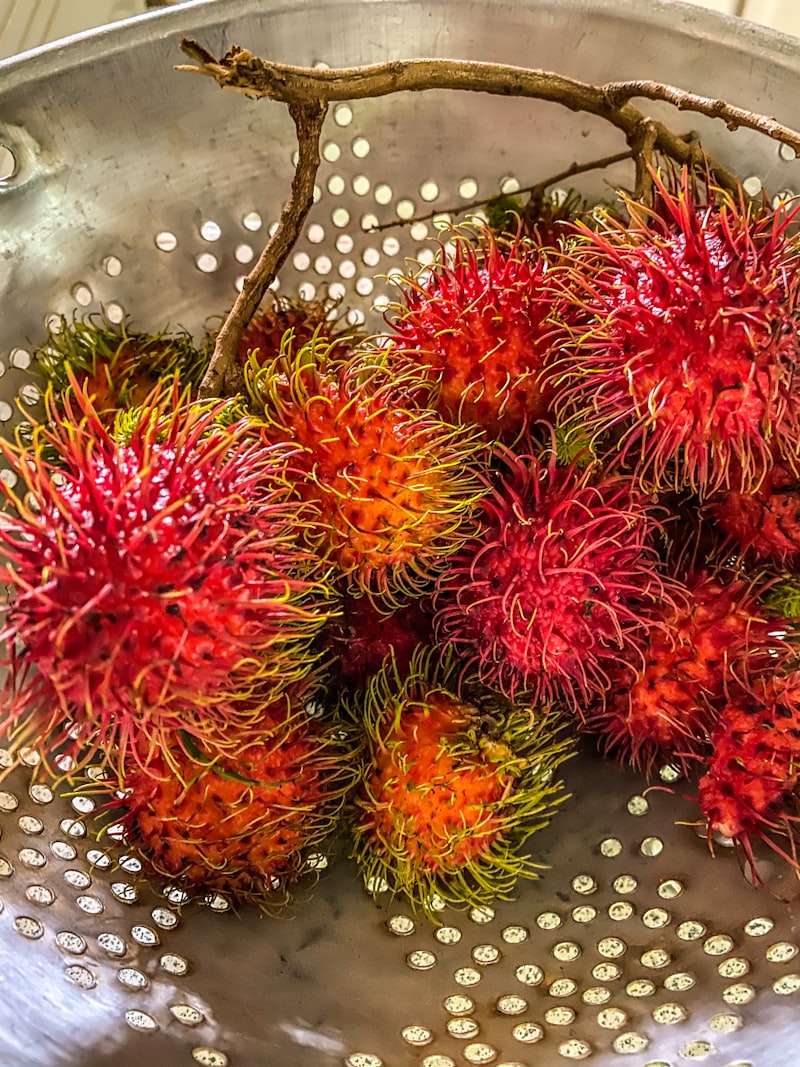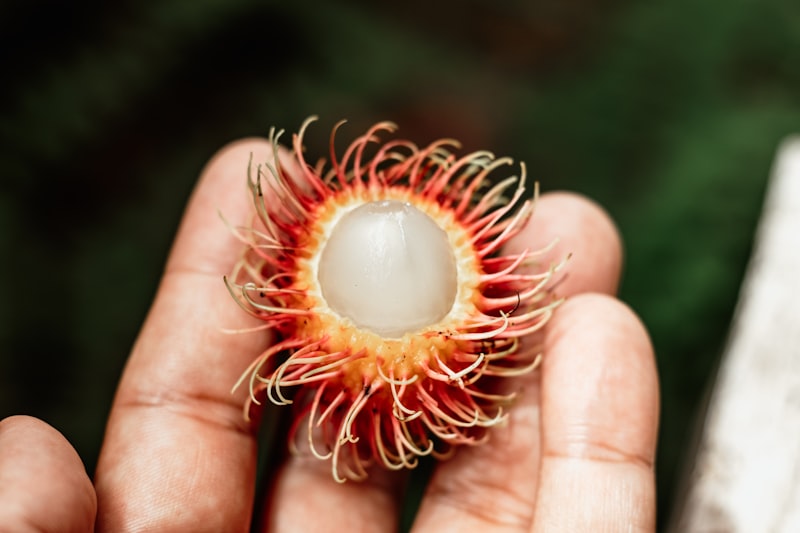Rambutan Fruit ⏬👇
Are you ready to embark on a culinary adventure? Allow me to introduce you to the enchanting world of rambutan fruit. Let’s dive right in and explore the juicy goodness this exotic fruit has to offer.
Picture a vibrant, hairy ball with a captivating red or yellow exterior, resembling a tiny sea urchin. That’s the rambutan fruit! Native to Southeast Asia, this tropical gem is now enjoyed worldwide for its unique appearance and delightful taste.
Once you peel away the spiky skin of the rambutan, you’ll reveal a translucent, juicy flesh that’s reminiscent of a lychee or grape. The texture is simultaneously firm and tender, inviting your taste buds to indulge in its succulence. Its sweet and slightly acidic flavor profile makes it a true delight for fruit enthusiasts.
But there’s more to rambutan fruit than meets the eye. It’s not just a feast for your taste buds; it also offers a range of health benefits. Packed with essential vitamins and minerals, this fruit is a fantastic source of vitamin C, iron, and copper. These nutrients support your immune system, enhance blood circulation, and promote healthy skin, leaving you feeling refreshed and nourished.

Not only is rambutan fruit delicious and nutritious, but it also adds a touch of elegance to any dish. Whether you incorporate it into a refreshing fruit salad, blend it into a tropical smoothie, or use it as a garnish for cocktails, rambutan fruit brings an exotic flair that will leave your guests in awe.
Now, you might be wondering how to choose the perfect rambutan at the grocery store or farmers’ market. Look for fruits with bright, vibrant skin and avoid those with blemishes or mold. When it comes to ripeness, go for fruits that yield slightly to gentle pressure. Trust your senses, and you’ll find yourself enjoying the divine taste of perfectly ripe rambutan.
Where does Rambutan Fruit grow?|Rambutan
Rambutan fruit is one of nature’s little marvels that captivates both the taste buds and the imagination. But have you ever wondered where this exotic delight actually grows? Let’s embark on a journey to uncover the origins of this delectable fruit.
Picture yourself in the lush tropical landscapes of Southeast Asia. It is here, among the rainforests and fertile lands, that the rambutan tree thrives. Native to countries like Indonesia, Malaysia, Thailand, and the Philippines, this region provides the ideal conditions for rambutan to flourish.
The rambutan tree, scientifically known as Nephelium lappaceum, is an evergreen tree that can reach heights of up to 80 feet. Its canopy of glossy green leaves offers shade and protection for the delicate clusters of rambutan fruits that hang from its branches.
As the name suggests, the rambutan resembles a hairy creature, with spiky red or yellowish skin covering its juicy flesh. These vibrant fruits are borne in abundance during the peak season, which typically falls between June and October in Southeast Asia.
To truly appreciate the rambutan’s growth process, let’s delve into the lifecycle of this remarkable fruit. It all begins with the tree’s flowers, which are small and fragrant. Bees, butterflies, and other pollinators diligently carry out their task of transferring pollen from male to female flowers, setting the stage for fruit formation.
After successful pollination, the flowers develop into oval-shaped fruits, covered in soft spines. As they mature, these spines transform into the distinctive red or yellow fuzz that encases the sweet, juicy flesh within. When fully ripe, the rambutan is ready to be plucked and enjoyed.
While Southeast Asia remains the heartland of rambutan cultivation, this delightful fruit has also found its way to other parts of the world with similar climates. Countries like Costa Rica, Ecuador, and Hawaii have embraced the rambutan, enabling fruit enthusiasts worldwide to savor its unique flavor and texture.
The rambutan fruit is a tropical gem that thrives in the enchanting landscapes of Southeast Asia. With its hairy exterior and luscious interior, it offers a delightful sensory experience. So, the next time you indulge in this captivating fruit, savor each bite and appreciate the journey it took from the fertile soils of Southeast Asia to your plate.
How to Prepare Rambutan?|Rambutan
Are you ready to embark on a culinary adventure and discover the delights of rambutan? This exotic fruit, with its vibrant red spiky exterior and succulent flesh, is a tropical treat that will transport your taste buds to paradise. But how do you prepare this captivating fruit? Let’s dive in and unveil the secrets of enjoying rambutan to the fullest.
First things first, before indulging in the deliciousness of rambutan, you need to know how to properly handle it. Start by selecting ripe fruits that have a bright, vibrant color. The spikes should be firm but not too sharp. Once you’ve chosen your perfect rambutans, give them a gentle rinse to remove any dirt or debris.
Now comes the exciting part—the art of peeling a rambutan. Hold the fruit firmly in one hand and make a shallow cut along the skin from top to bottom. Be careful not to press too hard as you want to avoid piercing the juicy flesh inside. Gently pry open the skin and reveal the luscious pulp nestled within.
Once your rambutan is peeled, marvel at the translucent, jelly-like flesh surrounding the seed. This delightful jewel can be enjoyed as is, but for an extra burst of flavor, try chilling it in the refrigerator before consuming. The coolness enhances the fruit’s juiciness, making each bite a refreshing delight.
Now, imagine sinking your teeth into the succulent flesh of a chilled rambutan. The explosion of sweetness and tanginess is like a tropical symphony dancing on your palate. It’s nature’s candy, bursting with juice and tantalizing flavors that will transport you to a sun-drenched beach.
Rambutan is incredibly versatile and can be used in various culinary creations. Add it to fruit salads, smoothies, or tropical desserts for a touch of exotic sweetness. You can even experiment with incorporating rambutan into savory dishes like salsas or stir-fries for an unexpected twist that will leave your guests in awe.
Preparing rambutan is a simple yet rewarding experience that unveils the exotic flavors hidden within this captivating fruit. From its vibrant appearance to its refreshing taste, rambutan is a true tropical treasure. So go ahead, embrace your inner culinary explorer, and let the wonders of rambutan enchant your senses.
How to Eat Rambutan Fruit?|Rambutan
Have you ever come across a peculiar-looking fruit with vibrant red spiky hairs and wondered how to eat it? Well, get ready to embark on a delightful tropical culinary adventure as we explore the art of consuming rambutan fruit. Native to Southeast Asia, rambutan is not only visually intriguing but also a deliciously sweet treat.
So, how do you enjoy this exotic fruit? Begin by gently holding the rambutan in your hand, feeling its soft and pliable exterior. Imagine it as nature’s tiny hedgehog, guarding a treasure within. Using a sharp knife, make a shallow incision around the circumference of the fruit, being cautious not to pierce the juicy flesh inside. Once you’ve created a complete circle, gently twist and separate the two halves.

Now, behold the inner beauty of the rambutan! Nestled inside the hairy shell lies a translucent, jelly-like flesh, resembling a shimmering pearl. To savor the fruit at its best, simply bite into the succulent flesh or use your fingers to peel away the skin. Feel the juice burst forth, tantalizing your taste buds with its sweetness.
As you relish the refreshing flavor, beware of the seed nestled within the flesh. Similar to an avocado pit, the rambutan seed is large and inedible. You can easily remove it by popping it out with your fingers or separating the flesh from it.
For those seeking a more creative serving suggestion, rambutan can be a delightful addition to various culinary creations. Slice the fruit into small pieces and toss them into a vibrant fruit salad, adding a burst of color and tropical sweetness. Alternatively, blend the peeled rambutan with ice and other fruits to create a luscious smoothie that will transport you to a beachside paradise.
In summary, indulging in the marvels of rambutan fruit is a true delight. With its captivating appearance and luscious flavor, this tropical gem offers a unique culinary experience. So, the next time you encounter a rambutan, remember how to open it, revel in its juicy flesh, discard the seed, and let your taste buds dance with joy.
What Goes with Rambutan?|Rambutan
Are you wondering what goes with rambutan? Well, let’s explore the delightful pairings that can elevate your experience with this exotic fruit. Rambutan, with its vibrant red skin and spiky appearance, is a tropical gem that hails from Southeast Asia. Its sweet and juicy flesh makes it a favorite among fruit enthusiasts around the world. But what should you eat with rambutan to enhance its flavor even more? Let’s find out!
One fantastic companion for rambutan is coconut. The creamy and refreshing taste of coconut perfectly complements the sweetness of rambutan. You can enjoy them together in a tropical fruit salad or blend them into a tantalizing smoothie. This combination will transport your taste buds to a sunny beach paradise.
Another great pairing is with pineapple. Both rambutan and pineapple share tropical origins, and their flavors harmonize beautifully. The tangy sweetness of pineapple balances the richness of rambutan, creating a delightful contrast. Try mixing them in a fruit salsa or adding them to a fresh fruit platter for a burst of tropical goodness.
If you’re looking for a unique twist, why not try combining rambutan with savory ingredients? The subtle sweetness of rambutan pairs surprisingly well with salty and tangy flavors. Consider adding sliced rambutan to a mixed greens salad with feta cheese and balsamic vinaigrette. The contrasting tastes will create a symphony of flavors on your palate.
For a decadent treat, chocolate and rambutan make an indulgent duo. Dip peeled rambutan in melted dark chocolate and let them cool for a heavenly dessert. The rich chocolate coating enhances the sweetness of the fruit, resulting in a luscious delight.
Rambutan is a versatile fruit that can be enjoyed in various combinations. Whether you choose to pair it with coconut, pineapple, savory ingredients, or chocolate, the possibilities are endless. Let your imagination run wild and experiment with different flavors to discover your favorite rambutan pairing. So go ahead, dive into the world of rambutan and unlock a symphony of taste sensations!
What are the Benefits of Rambutan Fruit?|Rambutan
Picture a tropical paradise where vibrant fruits hang from lush trees, enticing us with their exotic charm. In this enchanting realm, one fruit stands out with its peculiar appearance and delightful taste—the remarkable rambutan. But what exactly are the benefits of indulging in this captivating fruit? Let’s explore the wonders that lie within.
First and foremost, rambutan is a nutritional powerhouse. Bursting with vitamins and minerals, it offers a myriad of health benefits. Loaded with vitamin C, this spiky gem boosts your immune system, helping you fend off common ailments. Additionally, its impressive array of antioxidants fights against free radicals, promoting overall well-being and radiant skin. What a remarkable way to strengthen your body’s defenses naturally!
Are you seeking to maintain your youthful glow? Look no further. Rambutan contains an abundance of collagen-promoting nutrients, such as copper and proline. Collagen, often referred to as the “fountain of youth,” plays a vital role in maintaining skin elasticity and preventing premature aging. Including rambutan in your diet may help you retain that youthful radiance for longer.
But the benefits don’t stop there—rambutan offers a valuable ally in maintaining a healthy heart. Rich in potassium and fiber, it aids in regulating blood pressure and reducing cholesterol levels. By incorporating this delectable fruit into your diet, you can take proactive steps towards cardiovascular health while savoring its succulent sweetness.
Weight management enthusiasts, rejoice! Rambutan is low in calories, making it a perfect guilt-free snack option. Its high water content keeps you feeling full, helping curb those unnecessary cravings. So, if you’re on a quest to shed some pounds or maintain a healthy weight, rambutan can be your trusty companion on that journey.
Moreover, rambutan boasts a natural diuretic effect, aiding in kidney function and promoting fluid balance within the body. By consuming this juicy delight, you can support your urinary health and improve hydration levels simultaneously.
What are the Potential Harms of Rambutan?|Rambutan
Introduction: Have you ever come across the vibrant and exotic fruit called rambutan? This peculiar-looking fruit, with its hairy exterior and juicy flesh, is not only visually striking but also offers a unique taste experience. While rambutans are generally safe to consume and have numerous health benefits, it’s crucial to be aware of any potential harms that may arise from their consumption. In this article, we’ll explore some of the possible adverse effects of consuming rambutan.
Allergic Reactions: Although rare, some individuals may be allergic to rambutan. Allergies can manifest as itching, swelling, or hives on the skin, and in severe cases, they can lead to difficulty breathing or anaphylaxis. If you’ve never eaten rambutan before, it’s advisable to try a small amount first and monitor your body’s reaction.
High Sugar Content: Rambutan is known for its sweet taste, thanks to its natural sugar content. While this makes it a delightful treat, individuals with diabetes or those aiming to manage their blood sugar levels should consume rambutan in moderation. Excessive intake of high-sugar fruits like rambutan can cause a sudden spike in blood glucose levels, which may pose risks to individuals with certain medical conditions.
Digestive Issues: Eating rambutan in excess can lead to digestive discomfort. The fruit contains fiber, which, when consumed in large quantities, may cause bloating, gas, or diarrhea. It’s important to listen to your body and consume rambutan in reasonable portions to avoid such issues.
Pesticide Residue: Like many other fruits, rambutan may be treated with pesticides during cultivation to protect them from pests and diseases. Consuming rambutan without properly washing or removing the peel could expose you to pesticide residues. To minimize this risk, it’s advisable to wash the fruit thoroughly before consumption or opt for organic rambutans whenever possible.
Conclusion: While rambutan is generally safe to enjoy and offers several health benefits, it’s essential to be aware of the potential harms associated with its consumption. Allergic reactions, high sugar content, digestive issues, and pesticide residues are factors that should be taken into consideration. By being mindful of these aspects, you can savor the deliciousness of rambutan while ensuring your well-being. So go ahead, indulge in this exotic delight, and make the most of its unique flavors!



